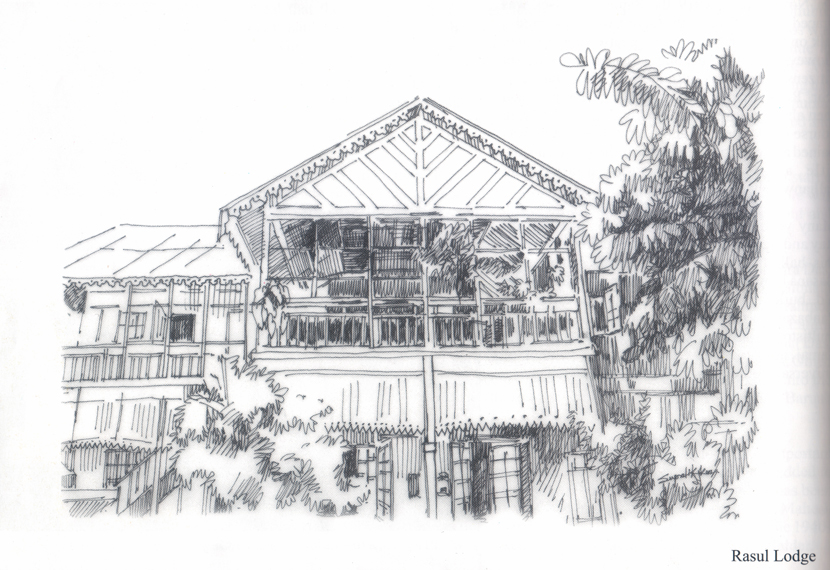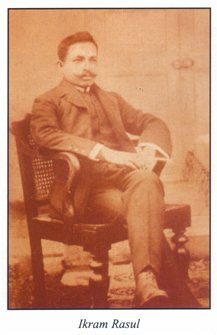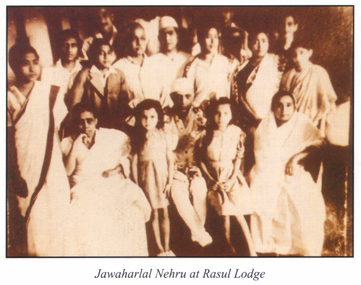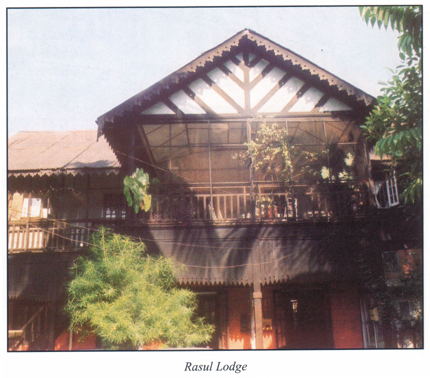| LIVING IN STYLE |
 |
Ikram Rasul of Lakhtokia loved to live in style. He was a connoisseur of good food, prized a collection of the latest English bestsellers of the times and made frequent trips to Calcutta as a pastime. All his clothes were stitched at the best tailoring house in Calcutta, and shirts from Harrods in London also adorned his closet.
Ikram Rasul started his career as a schoolteacher, but he was an enterprising young man and was soon elevated to post of Exercise Superintendent of Nagaon, and later of Sylhet. So when Rasul decided to construct a house at Lakhtokia, there were no doubts that it would be the most chic of all houses in town.
|
Architects were hired, models drawn up and altered, and finally a design chosen. The contract for construction of the house was given to Md Ida Khan. Iron beams and rods were made to order from the Tata Iron and Steel Company in Bihar while machine-made Burmese teak flooring, windows and doors were brought in from Calcutta by steamer. In 1910 when the double-storied, eight-bedroom bungalow was complete, it obviously became the talk of town. According to the Rasul family, the house called Rasul Lodge was the first two-storied house in Guwahati. The architecture of the house no doubt drew people to it like months to flame, but many made a beeline to Rasul Lodge also because of its warm hospitality. It became a home away from for several Mohammedan students who came all the way from upper Assam for higher studies at Cotton College. In 1928 a barrister from England also came and made Rasul Lodge his workplace. This young lawyer called Fakhruddin Ali Ahmed was destined later on to become the President of India. Ahmed was Ikram Rasul’s first cousin and it is while staying at Rasul Lodge that he started practicing law, and also began his political career. |
|
Rasul Lodge has had some other very interesting occupants as well. Ikram Rasul’s brother, Rafiqur Rasul, who was popularly known as Moina Mouzadar was one of them. Moina Mouzadar was the person who started the first cinema hall in the Assam province. Early trials of the cinema (bioscope) were held in the first floor drawing room of Rasul Lodge with the help of a generator that was also a novel thing those days. Even today old chairs of the “first class” and cinema tickets used by Moina Mouzadar’s Kamrup Cinema Company is preserved by the family.
|
|
As mouzadar of Panbari mouza that spread over a vast area from Panbari to Mirza, embracing almost entire Guwahati (excluding Beltola), Moina Mauzadar accumulated good money. He was a dynamic entrepreneur, and the second person in Guwahati to own two city buses in the 1930s. The buses, Queen and Nassiran, shared place of pride with the family phaeton in the campus of the house. |
The taste of Rasul Lodge’s residents is evident in the century-old furniture that graces its rooms. Most of the furniture, made of pure Burma teak, was procured from Messrs Hall and Anderson and Whiteway, two famous furniture shops of Calcutta in those days. In 1927 when electricity was introduced in town, Rasul Lodge was one of the first houses to acquire a connection and unique chandeliers and lamps from Belgium were bought to add to its style.
|
The Rasul family was closely associated with the Indian National Congress. Several Congress stalwarts not only visited the house but also stayed here. Jawaharlal Nehru stayed at Rasul Lodge for a few days in 1942. Ikram Rasul’s three surviving sons, Ataur Rasul, Ejaj Rasul and Imtiaz Rasul recall with nostalgia how Shaikh Brothers cheese straws were invariably served to Nehru during breakfast because he was so very fond of them. Khan Bahadur Mustaq Ahmed Girmani, who later became the governor of the Northwest Frontier Province of Pakistan was also a gust at the house. While fleeing from the police, Aruna Asaf Ali stayed here for several days. In 1945 Maulana Abul Kalam Azad also visited the Lodge. So did Rajendra Prasad and V V Giri later on. |
|


